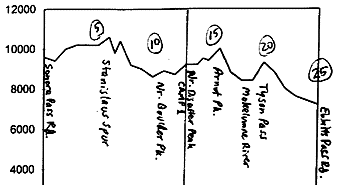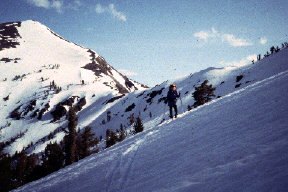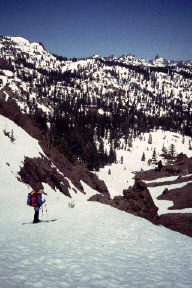


| |
| Stanislaus Peak |
From Sonora Pass, drive or ski alongside the road northwest for about a mile, before heading due north. Head over the ridge at an elevation of about 10200' to 10400', and contour along the west side of the Sierra Crest, to the south of Stanislaus Peak. Then continue to contour around Stan's west side, as it becomes a somewhat steep traverse around Stan's north side. Once on the east side of the crest, ski the bowl (above photo) down to the pass. Then follow the crest northward around the east side of Peak 10379'; this is best done by gaining about 100' or so towards the peak, and then doing a sort of steep traverse across the peak's east slopes.
Continue to traverse to a NE-facing gulley. Descend that a few hundred feet, and continue to traverse. There are some good campsite possibilities around here, with outstanding views of this canyon of the upper East Fork Carson.

| |
| Looking down Nobel Canyon |
Arnot Peak is named for an 19th century Alpine County superior court judge. And I'll bet he was mean too. Arnot's summit ridge is steeply corniced to the north and strewn with steep volcanic rubble to the south, so once you get to the summit ridge, you'll want to drop back down a few hundred feet to the south and traverse around the summit. Then climb back to about 9800' just west of Arnot and ski down the very fine north-facing bowl to the west of the summit. We took Camp 2 at the base of this run.
There are three options on the third day, so choose your poison: